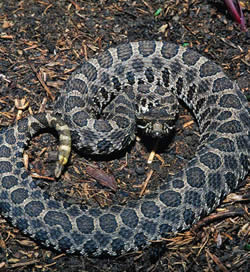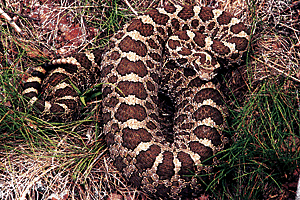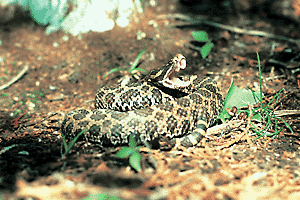What do Massasaugas Interact with?
Within their habitats, massasaugas are
surrounded by many different organisms. There
are many different ways the massasaugas interact
with their neighbors in the ecosystem.
One way the massasaugas interact with other organisms is by predation. They eat other animals, such as small mammals (mice or shrews), small snakes and lizards, frogs, or small birds. Of course, the predation only benefits the snake, not its unfortunate victim. The massasauga itself is a victim of predation by raccoons, foxes, coyotes, dogs, skunks, pigs, hawks, and eagles. Here is a link to a youtube video of a subspecies of Sistrurus catenatus eating (or at least biting, only the first twenty seconds are interesting) a live mouse. Don't watch it if you feel sorry for little furry animals. Watch the video here.
 Another way massasaugas interact with others in their
habitat is by
taking shelter underneath bushes and other
broad-leafed plants. When it hides under
plants, only the snake benefits from the interaction, and the
plant isn’t affected at all. This type of
interaction is called commensalism. The snake
can hide from predators or prey here, or just get out of the sun
if it is too hot.
Another way massasaugas interact with others in their
habitat is by
taking shelter underneath bushes and other
broad-leafed plants. When it hides under
plants, only the snake benefits from the interaction, and the
plant isn’t affected at all. This type of
interaction is called commensalism. The snake
can hide from predators or prey here, or just get out of the sun
if it is too hot.
A third way massasaugas interact with other species is by using their dens as hibernation sites. Finding hibernation sites is very important for massasaugas because they have no way to dig their own. Massasaugas usually hibernate in crayfish burrows near rivers, and probably just eat the former occupants of the den. They also can hibernate underneath trees in old root canals. This interaction is another example of commensalism, because the snake benefits, whereas the tree is unaffected.
Massasauga rattlesnakes also interact with humans.
In the past, there was a bounty on massasaugas in
Wisconsin. People were paid $5 by the
government of Wisconsin for every rattle they brought in.
The point of this bounty was to reduce the population of
a “pest species”. This bounty took a harsh
toll on the population of massasaugas in Wisconsin.
In 1975, the bounty was removed, but the damage was
already done.
Now that the bounty has been lifted, the massasauga
has been given a protected status in the state of Wisconsin.
Massasaugas are protected in many other states as well,
due to a diminishing population. They are
also studied for scientific research, and some are brought to
zoos so they can be shown to the public.
by the
government of Wisconsin for every rattle they brought in.
The point of this bounty was to reduce the population of
a “pest species”. This bounty took a harsh
toll on the population of massasaugas in Wisconsin.
In 1975, the bounty was removed, but the damage was
already done.
Now that the bounty has been lifted, the massasauga
has been given a protected status in the state of Wisconsin.
Massasaugas are protected in many other states as well,
due to a diminishing population. They are
also studied for scientific research, and some are brought to
zoos so they can be shown to the public.
To learn some interesting facts about the massasauga, go on to my interesting facts page here.